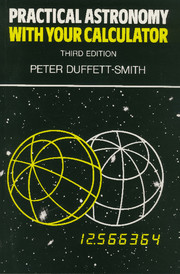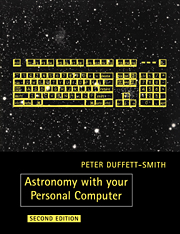Practical Astronomy with your Calculator
In its first two editions, Practical Astronomy With Your Calculator enjoyed tremendous success. Using clear and logical
Product details
June 2014Adobe eBook Reader
9780511251689
0 pages
0kg
41 b/w illus.
This ISBN is for an eBook version which is distributed on our behalf by a third party.
Table of Contents
- Preface to the third edition
- About this book and how to use it
- Part I. Time:
- 1. Calendars
- 2. The date of Easter
- 3. Converting the date to the day number
- 4. Julian day numbers
- 5. Converting the Julian day number to the calendar date
- 6. Finding the day of the week
- 7. Converting hours, minutes and seconds to decimal hours
- 8. Converting decimal hours to hours, minutes and seconds
- 9. Converting the local time to UT
- 10. Converting UT to local civil time
- 11. Sidereal time (ST)
- 12. Conversion of UT to GST
- 13. Conversion of GST to UT
- 14. Local sidereal time (LST)
- 15. Converting LST to GST
- 16. Ephemeris time (ET) and terrestrial dynamic time
- Part II. Coordinate Systems:
- 17. Horizon coordinates
- 18. Equatorial coordinates
- 19. Ecliptic coordinates
- 20. Galactic coordinates
- 21. Converting between decimal degrees and degrees, minutes and seconds
- 22. Converting between angles expressed in degrees and angles expressed in hours
- 23. Converting between one coordinate system and another
- 24. Converting between right ascension and hour-angles
- 25. Equatorial to horizon coordinate conversion
- 26. Horizon to equatorial coordinate conversion
- 27. Ecliptic to equatorial coordinate conversion
- 28. Equatorial to ecliptic coordinate conversion
- 29. Equatorial to galactic coordinate conversion
- 30. Galactic to equatorial coordinate conversion
- 31. Generalised coordinate transformations
- 32. The angle between two celestial objects
- 33. Rising and setting
- 34. Precession
- 35. Nutation
- 36. Aberration
- 37. Refraction
- 38. Geocentric parallax and the figure of the Earth
- 39. Calculating corrections for parallax
- 40. Heliographic coordinates
- 41. Carrington rotation numbers
- 42. Selenographic coordinates
- 43. Atmospheric extinction
- Part III. The Sun:
- 44. Orbits
- 45. The apparent orbit of the Sun
- 46. Calculating the position of the Sun
- 47. Calculating orbits more precisely
- 48. Calculating the Sun's distance and angular size
- 49. Sunrise and sunset
- 50. Twilight
- 51. The equation of time
- 52. Solar elongations
- Part IV. The Planets, Comets and Binary Stars:
- 53. The planetary orbits
- 54. Calculating the coordinates of a planet
- 55. Finding the approximate positions of the planets
- 56. Perturbations in a planet's orbit
- 57. The distance, light-travel time and angular size of a planet
- 58. The phases of the planets
- 59. The position-angle of the bright limb
- 60. The apparent brightness of a planet
- 61. Comets
- 62. Parabolic orbits
- 63. Binary-star orbits
- Part V. The Moon and Eclipses:
- 64. The Moon's orbit
- 65. Calculating the Moon's position
- 66. The Moon's hourly motions
- 67. The phases of the moon
- 68. The position-angle of the Moon's bright limb
- 69. The Moon's distance, angular size and horizontal parallax
- 70. Eclipses
- 72. The 'rules' of eclipses
- 73. Calculating a lunar eclipse
- 74. Calculating a solar eclipse
- 75. The Astronomical calendar
- Glossary of terms
- Symbols and abbreviations
- Index.





